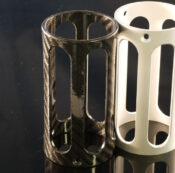Computer Numerical Control (CNC) machines are an efficient method of cutting, drilling and shaping materials.
This piece will look at the basics of operating a CNC machine.
CNC Machine Safety
When setting up work holding devices in a CNC lathe, it’s important that tool safety precautions are considered for:
- Tool selection
- Tool positioning
- Tool condition
- Tool post condition
These considerations are important to address at an early stage as a chopped or broken tool can result in an undersized or inaccurate workpiece. Furthermore, once the CNC has started it won’t stop until the program is finished or it is manually stopped, and so it’s important to ensure that the tool is cutting the job correctly.
Tool selection is important because, for example, if the diameter of a bar is being turned It requires a right hand cutting tool as this is the only way to get an effective and safe cut.
All CNC machines also have isolation switches which should be switched off before starting any job to avoid injury.
There are also many safety precautions to be taken for the protection of the machine operator as well as the machine. This includes:
- Ensuring the machine is isolated before interacting with the workpiece or bed
- Wearing correct PPE
- Ensuring heavy tools are handled in the correct way
At DPC, we abide by vigorous health and safety standards to ensure the safety of our entire team.
CNC CAD & CAM Software
CAD & CAM are used to design a job and program the manufacturing processes.
CAM software generates toolpaths for the CNC machine by using the CAD software drawings.
When using a CAD/CAM system the programmer is able to:
- run all the programming on the computer
- run a simulation to ensure that the program works
- download the program to the CNC machine
The machine operator can then specify the machining operations required and the CAM system will integrate these into a CNC program.
CAD/CAM software helps to improve efficiencies on CNC machines by increasing productivity, automatically translating designs into instructions, and enabling programs to be modified for use on other jobs with similar specifications.
CNC Workholding Methods & Devices
There are a range of workholding methods and devices used on CNC lathes including:
- Automatic jaws
- Manually tightened jaws
- Indexing chucks
- Collets
- Face plates
The most common types of jaws are automatic and manual 3 jaw, however 4 jaw chucks are often used depending on the type of job being machined.
 It is important to set the workholding devices point in relation to the jobs datum point so there are no errors within the program; setting a datum point tells the machine the first point of cutting so setting it incorrectly or not setting it at all will result in the machine cutting at incorrect points and distances.
It is important to set the workholding devices point in relation to the jobs datum point so there are no errors within the program; setting a datum point tells the machine the first point of cutting so setting it incorrectly or not setting it at all will result in the machine cutting at incorrect points and distances.
Setting a home point is also important as it tells the tool where to return to. If a home point is not set the machine will not start up; when it is set it should be away from the job and at no risk of hitting anything in the machine.
CNC Basic Operating Modes
The basic modes of CNC operation are:
- Manual mode
- MDI (Manual Data Input mode)
- Single block mode
- Edit mode
- Automatic mode
Once the correct operation mode is selected, the program will be written and in some cases, a simulation will run before the program is executed.
Materials For CNC Machining
Different materials for CNC machining require different cutting speeds and feeds, so it is important to consider cutting speeds and feeds to the correct material type and tool tips.
The cutting speeds and feeds affect the surface finish of the job. When doing roughing cuts, it is possible to run at a slower spindle speed and faster feed speed to take off more material; this yields time and swarf efficiencies but a rough finish. For a better cut, the machine would be run at a higher RPM and a slower feed speed to yield a better surface finish.
The material hardness also is a big factor of the speeds and feeds, softer materials can be cut with bigger cuts on a faster speed, however harder materials need slower speeds and feeds, so the tip doesn’t wear or break.
Different material tips are selected based on the material being cut, the speeds and feeds being used and the tool it is going into.
When choosing a tip, the radius of the tip as well as the material must be taken into account.
For example, a .4 tip is best used for a finishing cut because it leaves a smoother finish. Whereas a .8 tip is better for roughing cut because it can take more material at a time due to its large surface area.
CNC Machine Tools
There are a range of standard cutting tools used on a CNC lathe, including:
- Facing / Turning
- Grooving
- Boring
- Threading
- Part off
- Centre drilling
- Twist drills
Tools are held in a CNC lathe with tool post magazines, which are the most common tool holding method used in older CNC machines.
Carousels are large tool holders that hold multiple tools so the tools can be easily switched around while machining. Carousels are used on most modern CNC machines because it creates time efficiencies when machining by eliminating the need to swap tools after each process.
To find out more about DPC’s CNC machining, please get in touch.









